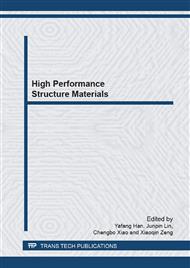p.723
p.733
p.739
p.747
p.754
p.760
p.765
p.772
p.777
Effect of Mo on the High Temperature Oxidation Behavior of Co-Al-W Based Alloys
Abstract:
2 at.% and 4 at.% Mo were added to Co-9Al-9W-2Ta-0.02B alloy to replace W (hereafter referred to as the alloys of 2Mo and 4Mo, respectively; Mo-free alloy was referred to as the 0Mo alloy). The effects of Mo additions on the high temperature oxidation behavior of the alloys at 800 °C in air have been studied. The results indicated that, after oxidation in air at 800 °C for 100 h, the oxide film of the 0Mo alloy remained intact, but the cracking and spallation of the oxide film took place in the alloys of 2Mo and 4Mo. Oxidation kinetic curves revealed weight gain per unit area of the 0Mo alloy was 36.86 mg·cm-2, which was lower than that of the alloys of 2Mo (65.16 mg·cm-2) and 4Mo (48.54mg·cm-2). These suggested that the 0Mo alloy displayed superior oxidation resistance compared to the alloys of 2Mo and 4Mo caused by the formation of volatile MoO3 oxide, and sharp compressive stress formed in the outer layer during the oxidation. The oxide layer was composed of three layers of the Co3O4 + CoO outer layer, middle complex oxide layer containing Co, Al and W (Mo), inner Al2O3 layer and γ/Co3W zone adhere to the γ/γ' substrate.
Info:
Periodical:
Pages:
754-759
Citation:
Online since:
February 2013
Authors:
Price:
Сopyright:
© 2013 Trans Tech Publications Ltd. All Rights Reserved
Share:
Citation:


